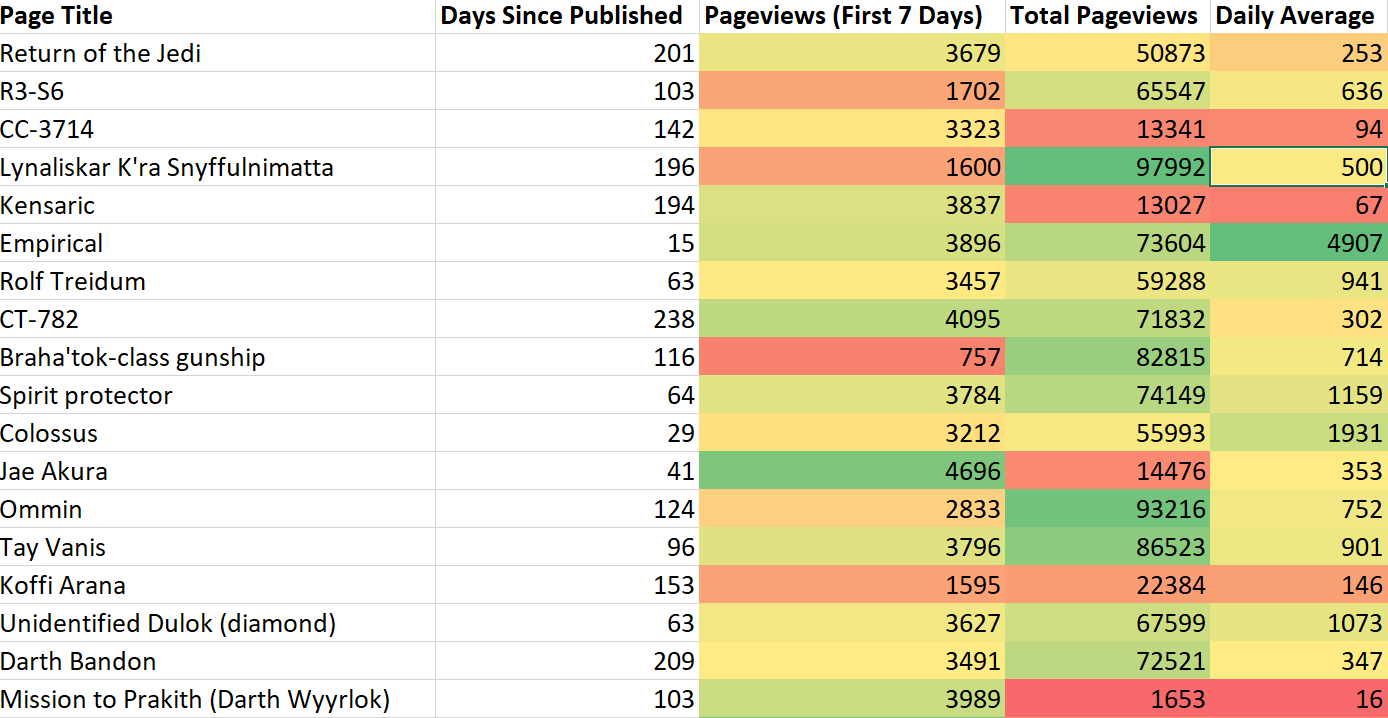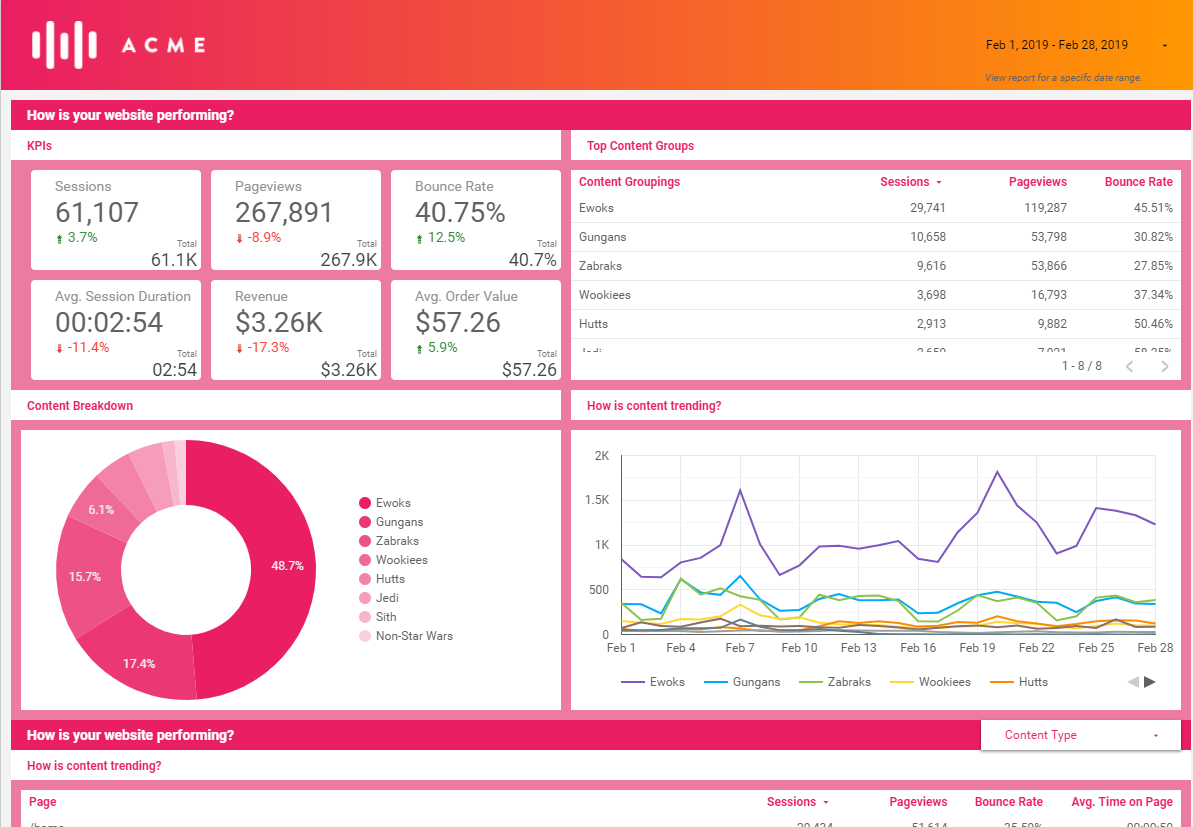1. Evergreen content analysis
‘Evergreen’ is a term now so overused it’s become almost meaningless – partly due to the fact that not many content managers have reporting set up to understand whether their content really is evergreen.
Many content managers label a piece of content that can stay relevant over a period of time as evergreen, but evergreen shouldn’t just be about consistent relevancy over time, it should be about consistent performance over time.
This is where collaboration with your analytics team comes in. If you’re truly interested in understanding the sustainable value of evergreen content, you can set up reports that measure the value of that content over time by measuring average daily views from publish date.
Pulling all data since publishing, rather than looking at isolated months, means you can understand the sustained or diminishing return on that content, and whether the value truly is evergreen. This is brilliant for getting away from the jargon around evergreen content and understanding if your piece was valuable at first but quickly dropped off, or if it stood the test of time and deserves more investment.

In terms of efficiencies, this helps you prioritise which topics to invest time in. Just because a piece only performs excellently for a month doesn’t mean it’s worthless, but it might be worth distributing your time proportionately towards content you know is going to be viewed and engaged with consistently over time.
2. Word count vs. engagement
Understanding how much copy you should be producing, and whether there is value in creating long form pages on your site is extremely important when understanding whether you are investing in the right ways.
Good copy needs investment, and investment requires proof of worth.
By working with your analytics team to implement a tailored engagement tracking plan, you’ll be able to actively measure how people are interacting with your content and whether there is value in producing longer pieces of content.
Bounce rate can give you an indication as to whether a page is engaging your audience, but there are more accurate and in-depth ways to measure how engaged your audience is.
Scroll tracking is a good way to get an understanding of how far down the page your audience are going. This is particularly interesting if you’re looking to understand long-form performance.
However, this isn’t quite enough to truly understand how interested your audience is in your content.
Things get much more insightful when you compare scroll depth to time on page, to give yourself a clear profile of behaviour on the page. Scroll depth will tell you how far your audience are scrolling, but align that with time on page and you’ll be able to decipher whether people are consuming the content you’ve produced.
Pair that with the content journey to conversion tracking in section three and you’ve got a clear understanding of how your consumers are engaging with content, and how that engagement is contributing to conversion.
3. Editorial dashboarding
A proper editorial dashboard is a collaboration between content and analytics. For your analytics team to put together an editorial dashboard they need to understand your priorities, and for you to brief your dashboard in properly you need to understand the measurement and tracking potentials.
How much you want to invest in editorial dashboarding will vary hugely depending on website size and traffic, but here’s a bit of inspiration to help you think about what you might want to measure:
- Author performance: Perfect for helping you understand which authors your audience respond to best.
- Group assisted conversions: Vital for most businesses, this gives you a view on which content groups are contributing the most to conversions.
- Topic performance: An overview of how each editorial topic is performing, helping you build a reactive editorial calendar based on performance each month.
- Format performance: The same as above, but for formats. This can help you understand whether longer or shorter posts perform best, whether you should include video in your editorial strategy or how imagery impacts content performance.

When built and used properly, an editorial analytics dashboard reviewed on a regular basis can feed a reactive editorial strategy centred around performance.
Particularly in fast paced industries, being reactive is essential. However it’s also dangerous as you can end up rushing into investing time in the wrong places. Investing time in a reactive dashboard means that even if decisions are made quickly, they’re made based on sound data that you can trust.
4. Content journey to conversion
Again, this is utterly essential information for any marketer responsible for content.
Gaining knowledge around how people have been led from content to a conversion, and what type of content has influenced them should be the bedrock of any content strategy.
As per any other reports, building this will need close collaboration with your analytics team but broadly you should be able to answer questions like:
- What have people read before signing up to your mailing list? You can use this to understand how people are using content to build loyalty towards your brand, and what type of content is garnering the desire to have future marketing communications.
- What content types have influenced subscription numbers or active conversions? Specifically, how are guides, blog posts, case studies, testimonials and so on influencing individual consumers’ propensity to convert? You can then use this to understand how your content can be impactful: is it used to reassure consumers? to inspire them? or to give them specific information that helps a buying decision move forward?
5. Tracking clicks on jump links
A very quick bonus tip here: it may seem obvious, but it’s an often-forgotten part of content tracking! Many long form posts include jump links to help audiences reach the most relevant part of a page quickly, this is something we use often in our resources section.
Don’t forget to track clicks on these links! Not only does this give you an understanding of how people are using the content, it gives you clarity on any areas of significant interest to your audience that might benefit from more content.
Hopefully you’ve found these tips useful, but if you take anything away from this piece it would be to set up a meeting with your analytics team and get collaborating on measurement right away. Measuring the true value of content is vital, but it’s also complex and takes varied skillsets.
By driving collaboration between content and analytics, you’ll be able to achieve superior results by making decisions with data you can trust.
Despite this being a no-brainer, so many brands are trailing behind when it comes to content performance tracking so get ahead of the game and get in the room with an analytics team!
